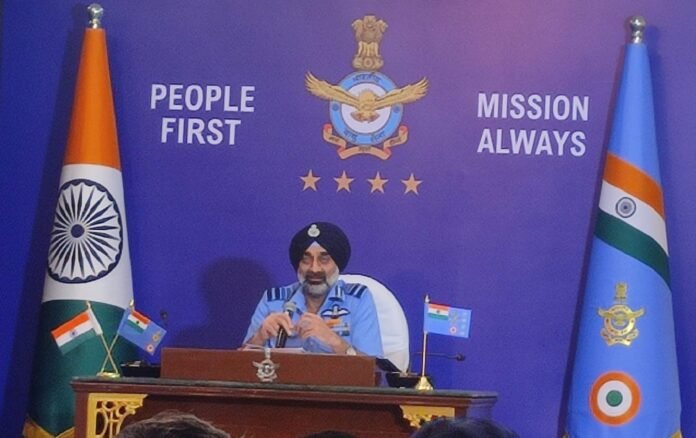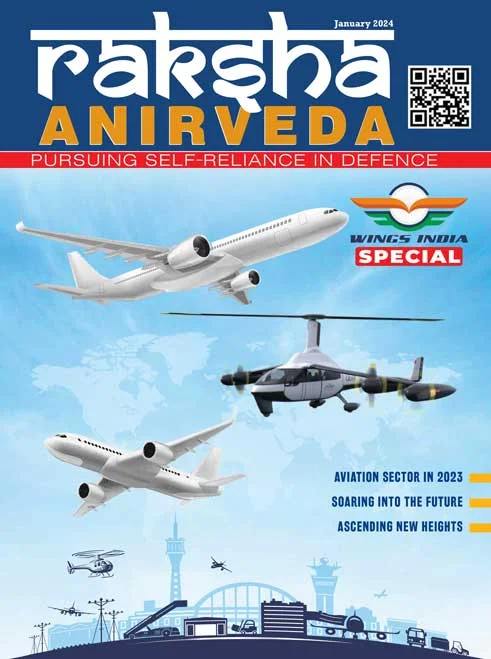New Delhi. Chief of the Air Staff, Air Chief Marshal Amar Preet Singh on Friday (October 4) said that China is rapidly building infrastructure along the Line of Actual Control (LAC), especially in the Ladakh sector, while India is also upgrading its infrastructure along the border.
Addressing his first press conference as the IAF’s new Chief, he took over as the new IAF chief only last month from former Air Chief Marshal VR Chaudhari Air, ACM AP Singh was addressing the media for the first time, just days before the annual Air Force Day on October 8.
In a very candid manner without mincing words, ACM AP Singh touched upon almost every issue relevant to the IAF and country’s defence in a forthright manner.
He spoke on the geopolitical tensions and global conflicts and said it is important to have indigenous weapons systems to deal with any future security challenges. “The Indian Air Force should have entire inventory produced in India by 2047,” he said. It is important to have indigenous weapons systems to deal with any future security challenges, he further said.
An ace test pilot, ACM Singh was commissioned into the fighter pilot stream of the IAF in December 1984. During his long and distinguished service spanning nearly 40 years, he has served in a variety of command, staff, instructional and foreign appointments.
An alumnus of the National Defence Academy, Defence Services Staff College, and National Defence College, he is a Qualified Flying Instructor and an Experimental Test Pilot with more than 5,000 hours of flying experience on a variety of fixed and rotary wing aircraft.
ACM AP Singh very clearly highlighted the lessons learnt from the ongoing Israel-Iran conflict and how the IAF plans to adapt to the changing technological advances to ensure India’s security in the coming years. He also emphasised the importance of having advanced air defence systems like Israel’s Iron Dome while speaking about the current Israel-Iran conflict.
“We are buying systems similar to the Iron Dome, but we need more of them. Right now, we must strategically identify and prioritise vital areas, as our numbers are limited. This situation underscores the importance of preparing for aerial threats, and we are making the necessary adjustments,” he said.
In a very candid manner without mincing words, ACM AP Singh touched upon almost every issue relevant to the IAF and country’s defence in a forthright manner. He reaffirmed the IAF’s push towards self-reliance, with plans for developing aircraft and weapons systems entirely within India
Air Chief Marshal Singh also acknowledged the global supply chain issues caused by ongoing conflicts, impacting military operations around the world. “We are managing ourselves well despite the challenging war situations globally,” he said confidently.
“Our focus has been on training in war-like scenarios and always maintaining operational readiness. Surface-to-air guided weapons are also kept ready in key areas to ensure that we can respond swiftly to any threat,” he added.
The IAF is not only focused on equipment but also on honing its personnel’s skills, he further said. “We conduct a lot of exercises to exchange ideas and learn from others,” he explained, referring to exercises such as Vayu Shakti, Tarang Shakti and Gagan Shakti. The Gagan Shakti exercise alone saw over 7,000 sorties, showcasing the Air Force’s commitment to being combat-ready.
ACM Singh reaffirmed the IAF’s push towards self-reliance, with plans for developing aircraft and weapons systems entirely within India.
“We are working on projects like Tejas, Tejas Mk2, AMCA, ASTRA and large long-range weapons. Surface-to-air guided weapons like MRSAM and AKASH are also a priority,” he said.
In a blunt assessment of the IAF vis-à-vis China’s PAF, he said India needed to “catch up” on technology as well as on production speed of military equipment, “we are way behind our neighbour,” he said.
Speaking about the Eastern Ladakh situation, he said that while the overall scenario on the India-China border remained stable, the rapid infrastructure development on the Chinese side has prompted India to match the pace. “We are enhancing our own capabilities by building more Advanced Landing Grounds (ALGs) and new air bases to ensure preparedness in this sensitive region,” he said.
In a blunt assessment of the IAF vis-à-vis China’s PAF, AP Singh said India needed to “catch up” on technology as well as on production speed of military equipment, “we are way behind our neighbour,” he said
Air Chief Marshal Singh also touched on the IAF’s efforts to strengthen its space-based systems. “We have a requirement for new satellites as part of the SPS 3 programme, and we are in talks with ISRO,” he said. “Training is already underway at the Centre for Air Warriors in Hyderabad,” he further added.
On HAL and production of indigenous jets, he took HAL to task and said, “It (HAL) made a promise that production rates will be increased to 24 aircraft per year. If that promise is kept, delays can be caught up with. HAL has a third production line at Nashik, which is yet to churn out an aircraft.”
He emphasised the need to learn from past delays and push forward with plans like the Medium Role Fighter Aircraft (MRFA) programme. “We have made our requirements very clear and we are waiting for responses. Importantly, these aircraft must be made in India,” he said.
On HAL and production of indigenous jets, he took HAL to task and said, “It (HAL) made a promise that production rates will be increased to 24 aircraft per year, but that has not happened”
The IAF had placed an order with HAL for 83 Tejas Mark-1A jets. Deliveries were to start in March this year, but so far, not a single plane has been delivered.
On future production of indigenously designed fighter jets, he said the force was looking at 97 more Tejas Mark-1A, and also six-seven squadrons each of Tejas Mark 2 and Advanced Medium Combat Aircraft (AMCA).
Asked how so many planes could be produced by HAL or any state vendor, he said, “Private players have to come in. I don’t think we can continue relying only on one agency (HAL) that may have limitations of doing things in a specified time frame.”
On the future of a multi-role fighter aircraft (MRFA) JV programme that would manufacture 114 jets with a foreign partner in India, the IAF Chief said, “We needed the MRFA as of yesterday.”
“If the Tejas Mark 2 gets into production, as planned, by 2028, and MRFA is signed, we are not too badly off. If these timelines are getting pushed, we have to look at alternatives,” he said.
On future production of indigenously designed fighter jets, he said the force was looking at 97 more Tejas Mark-1A, and also six-seven squadrons each of Tejas Mark 2 and Advanced Medium Combat Aircraft (AMCA)
On the dwindling fleet of fighter jets, the Air Chief said, “Our first aim is not to let aircraft strength remain below 30 (squadrons).”
Each IAF squadron has 16-18 jets. The Cabinet Committee of Security has laid down the need for 42 squadrons to tackle a simultaneous two-front threat from China and Pakistan. But in reality, the IAF presently has only 32 squadrons with several scheduled to be phased out over the next few years.
One of the key challenges for the IAF is maintaining fighter strength amid depleting numbers. “We are focusing more on training and preserving the assets we have, especially as the production of Tejas has been delayed,” the Air Chief Marshal admitted.
Perhaps for the first time a chief of any arm of the Indian military has candidly and boldly put forward the requirements and delays of equipment for his force in such a forthright manner. It remains to be seen how the bureaucrats at the Indian Defence Ministry will take this and respond to this real situation, being faced by a force which has always performed heroically to ensure nation’s security and defence.
-The writer is a New Delhi-based senior commentator on international and strategic affairs, environmental issues, an interfaith practitioner, and a media consultant. The views expressed are personal and do not necessarily carry the views of Raksha Anirveda










